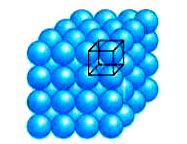Explain three dimensional close packing from two dimensional square close-packing.
Text Solution
Three dimensional structures is obtained by stacking two dimensional layers one above the other.

In this type of arrangement, the second square closed packed layer is placed exactly above the first square close packed layer such that the spheres of first and second layers are in same alignment horizontally and vertically and in the similar way more layers can be placed one above other.
If the arrangement of spheres in the first layer is called ..A.. type, then all the layers have the same arrangement. Thus this lattice has AAAAA.... type arrangement and the lattice thus generated is simple cubic unit cell or primitive cubic unit cell. The coordination number of each sphere is six.
|
Topper's Solved these Questions
- THE SOLID STATEBOOK - KUMAR PRAKASHANCHAPTER - THE SOLID STATEEXERCISE - SECTION - A (EXAMPLES)
5 Videos
- THE SOLID STATEBOOK - KUMAR PRAKASHANCHAPTER - THE SOLID STATEEXERCISE - SECTION - B (INTEXT QUESTIONS AND ANSWERS)
23 Videos
- THE SOLID STATEBOOK - KUMAR PRAKASHANCHAPTER - THE SOLID STATEEXERCISE - SECTION - E (MULTIPLE CHOICE QUESTIONS)(MCQs ASKED IN BOARD EXAMS)
35 Videos
- THE P-BLOCK ELEMENTS BOOK - KUMAR PRAKASHANCHAPTER - THE P-BLOCK ELEMENTS EXERCISE - SECTION-E (MULTIPLE CHOICE QUESTIONS (MCQS)) (MCQS ASKED IN BOARD EXAM)
77 Videos
Similar Questions
Knowledge Check
Three-dimensional close packing in solids is referred to as stacking the second square closed packing exactly above the first. In this tight packing, the spheres are horizontally and vertically correctly balanced. Similarly, we can obtain a simple cubic lattice by adding more layers, one above the other. This can be done in two ways. Three-dimensional close packing from two-dimensional square close-packed layers: By putting the second square closed packing exactly above the first, it is possible to form three-dimensional close packing. In this tight packing, the spheres are horizontally and vertically correctly balanced. Similarly, we can obtain a simple cubic lattice by adding more layers, one above the other.Three-dimensional close packing from two-dimensional hexagonal close-packed layers: With the assistance, of two-dimensional hexagonal packed layers, three-dimensional close packing can be obtained.
The coordination number of cubic closed packing is:A6B8C12D4Three-dimensional close packing in solids is referred to as stacking the second square closed packing exactly above the first. In this tight packing, the spheres are horizontally and vertically correctly balanced. Similarly, we can obtain a simple cubic lattice by adding more layers, one above the other. This can be done in two ways. Three-dimensional close packing from two-dimensional square close-packed layers: By putting the second square closed packing exactly above the first, it is possible to form three-dimensional close packing. In this tight packing, the spheres are horizontally and vertically correctly balanced. Similarly, we can obtain a simple cubic lattice by adding more layers, one above the other.Three-dimensional close packing from two-dimensional hexagonal close-packed layers: With the assistance, of two-dimensional hexagonal packed layers, three-dimensional close packing can be obtained.
The correct statement about zns crystal is:ACoordinate number (6:4): hcp, Zn2+ ions in all octahedral voidsBCoordinate number (6:6): hcp, Zn2+ ions in all tetrahedral voidsCCoordinate number (4:4): ccp, Zn2+ ions in the alternate tetrahedral voidsDCoordinate number (4:4): ccp, Zn2+ ions in all tetrahedral voidsThree-dimensional close packing in solids is referred to as stacking the second square closed packing exactly above the first. In this tight packing, the spheres are horizontally and vertically correctly balanced. Similarly, we can obtain a simple cubic lattice by adding more layers, one above the other. This can be done in two ways. Three-dimensional close packing from two-dimensional square close-packed layers: By putting the second square closed packing exactly above the first, it is possible to form three-dimensional close packing. In this tight packing, the spheres are horizontally and vertically correctly balanced. Similarly, we can obtain a simple cubic lattice by adding more layers, one above the other.Three-dimensional close packing from two-dimensional hexagonal close-packed layers: With the assistance, of two-dimensional hexagonal packed layers, three-dimensional close packing can be obtained.
What will be the ratio of radii of the spheres in cubic systems simple cubic, body centred cubic and face centred cubic systems. if 'a' stands for the edge length.A12a:√34a:12√2aB12a:√3a:1√2aC1a:√3a:√2aD12a:√32a:√22a
What is the two-dimensional coordination number of a molecule in square close-packed layer?
View SolutionWhat is the two-dimensional coordination number of a molecule in square close-packed layer?
View SolutionThe difference in coordination numbers of hexagonal close packing in 3D and square close packing in 2-D, of identical spheres is:
View SolutionWhat is the two dimensional coordination number of a molecule in (i) square close-packed layer (ii) hexagonal close-packed layer.
View SolutionWhat is the two-dimensional coordination number of a molecule in square close-packed layer?
View Solution
